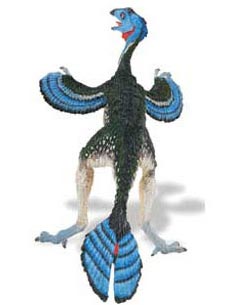Reverse Genetic Engineering turning a Chicken into a Dinosaur
Darwin devoted a proportion of his scientific studies in preparation for the publishing of his theory on natural selection “The Origin of Species” first published in 1859 to a study of animal and human embryos, however, we think he would have been surprised as scientists aim to manipulate bird genes in a research programmed nicknamed the “dinochicken” project. The great English scientist was keen to examine the development of different species demonstrating the “complex relations of all animals and plants throughout nature”; as Darwin put it.
For Darwin, he could see the linkages that supported his theory, but he was not sure what the mechanism for natural selection was. It was not until the 20th Century and the developments in genetics, that gave scientists a greater insight into the structure and make up of organisms.
The link between the ancestry of birds and dinosaurs had been postulated during Darwin’s lifetime. Indeed it was scientists such as Huxley, the great Darwinist supporter who had put forward the treaty that small, bipedal dinosaurs could have given rise to birds. Such a theory was supported by the Solnhofen fossils of Archaeopteryx, a creature with both avian and reptilian characteristics.
The “Dinochicken” Project
Now a team of palaeontologists and researchers from the University of Montana want to go further and reverse engineer dinosaur features from a chicken embryo. It has been known for some time that by manipulating proteins in a developing embryo ancient characteristics buried deep in the genetic make up of an organism can be “turned on”. Extended elements of the birds tail bones, the pygostyle has been achieved in the past. The pygostyle is the remnant of the dinosaur tail, it consists of the last five caudal vertebrae that have been reduced and eventually fused to form a plate of bone. Small needle-like teeth have also been formed by chicken embryos, reflecting their meat-eating dinosaur ancestors. Modern birds (neornithes) do not have teeth in their beaks. Teeth are heavy and require robust jaws to house them, so to reduce weight (very helpful in fliers), the toothless beak has evolved. However, more primitive birds such as the Hesperornithiforms from the Cretaceous had teeth.
However, the Montana University team intend to go further than other scientists and try to develop a number of reptilian characteristics at the same time. Project leader Jack Horner referring to the plan to reverse engineer a chicken embryo suggested that the American team would create a “chickenosaurus” or perhaps a “dinochicken”.
Reverse Engineering a Chicken – Could Dinosaurian Traits be Produced?

Picture credit: Everything Dinosaur
Caudipteryx
The picture above is of the small, feathered dinosaur Caudipteryx (Caudipteryx zoui). Caudipteryx fossils show that this animal was a close relative to birds but not a direct ancestor. This dinosaur is one of a number of feathered dinosaurs found in Cretaceous aged sediments in the Liaoning Province of China.
This is the first time that genetic experts have tried to bring back several dinosaurian characteristics, such as a teeth, tail and forearms, by changing the levels of regulatory proteins that have evolved to suppress these characteristics in Aves.
To see a model of Caudipteryx and other feathered dinosaur figures: Dinosaur and Prehistoric Animal Models.
Similar experiments have been performed on mice and insects, but for Horner this is not really playing God or meddling with the DNA, just turning on the genes to bring the dinosaur tail back on a creature whose ancestors would have possessed one anyway. This type of research could be carried out on any member of the neornithes, but the chicken has been chosen as their genome has already been precisely mapped and their embryos extensively studied.
It is the research team’s intention to extend the vertebrae to grow the tail, reverse engineering the pygostyle and producing an animal with unfused caudal vertebrae. Already, tail-like structures have been developed in birds using these protein juggling methods, but this is the first time that such extensive re-programming of an embryo will have taken place.
There is no chance that a fearsome meat-eating dinosaur will be produced, but this research is helping to improve our knowledge relating to spinal cord development. Studies and research work such as this could have important benefits for medical science.






Leave A Comment